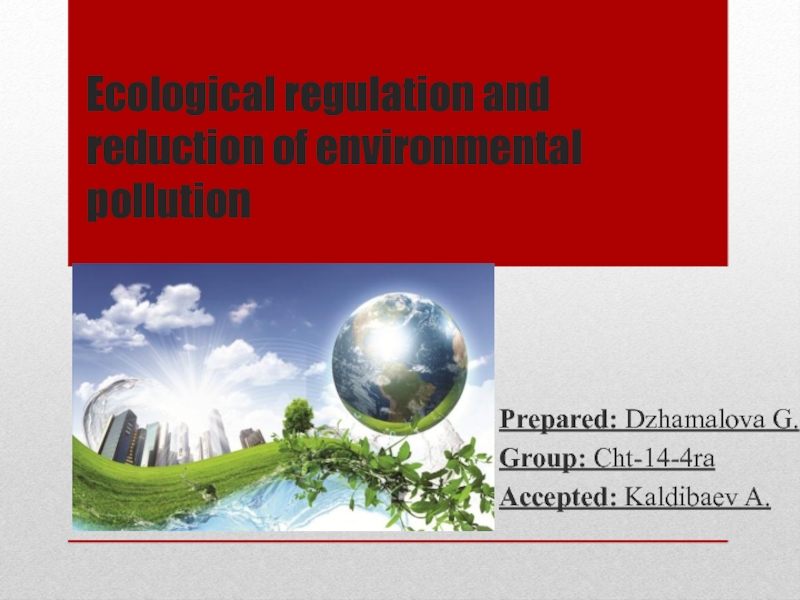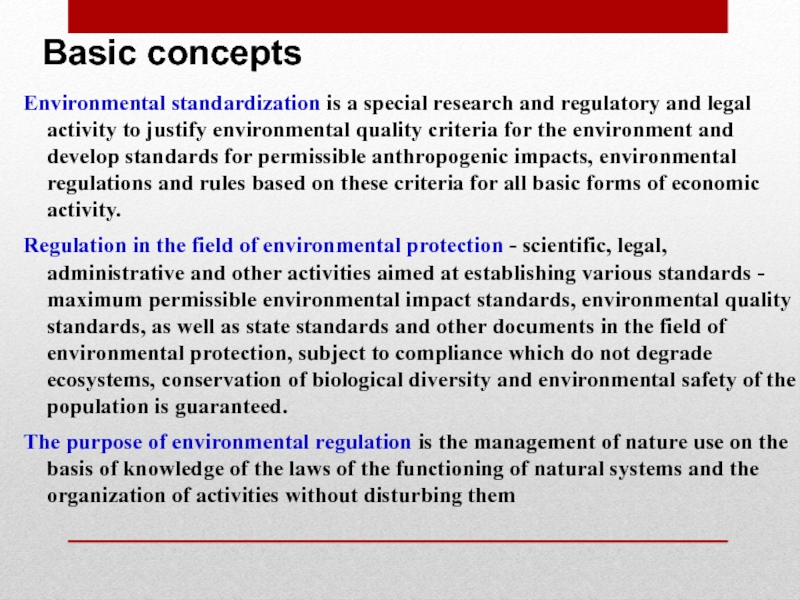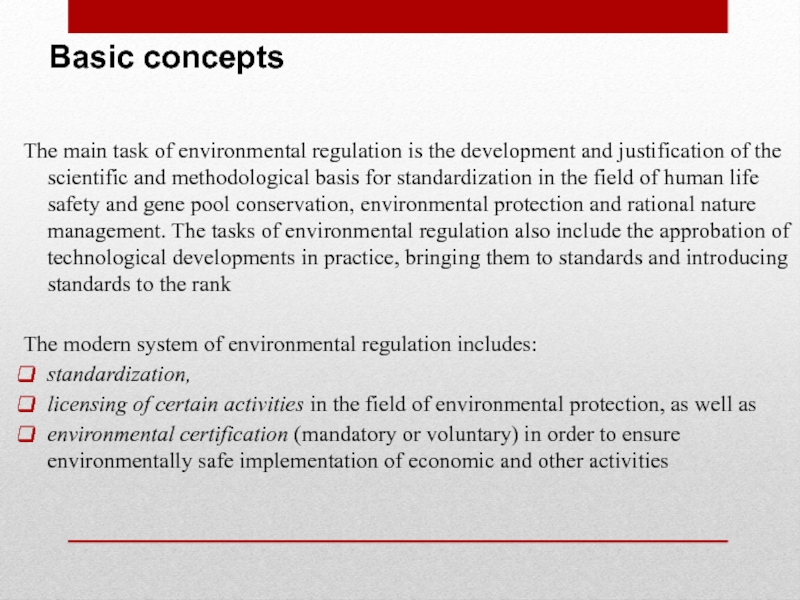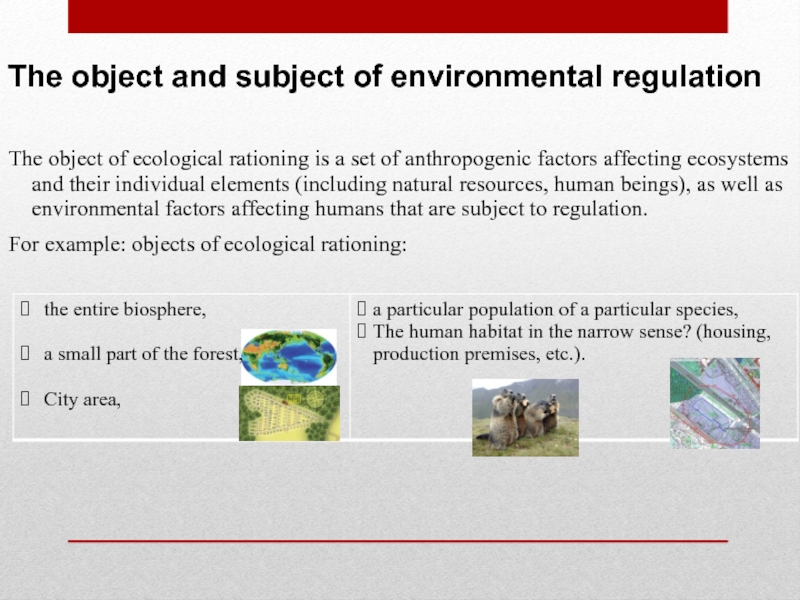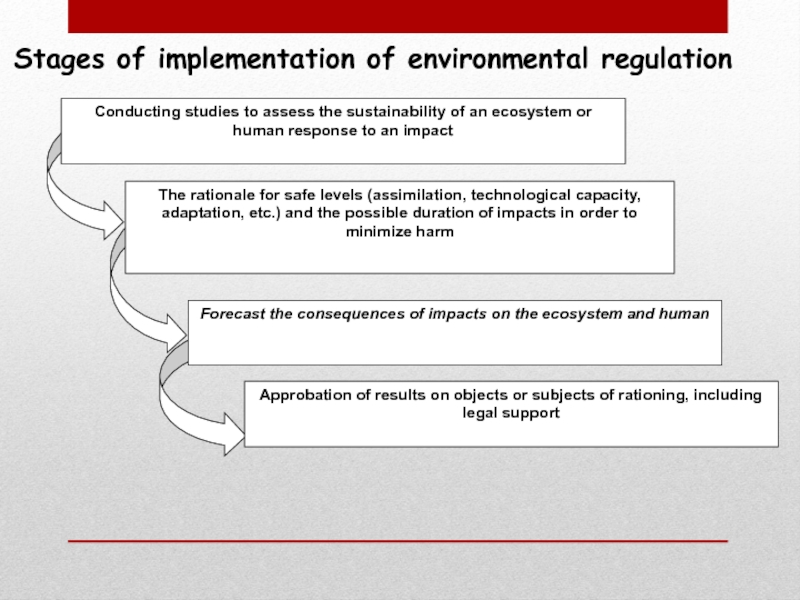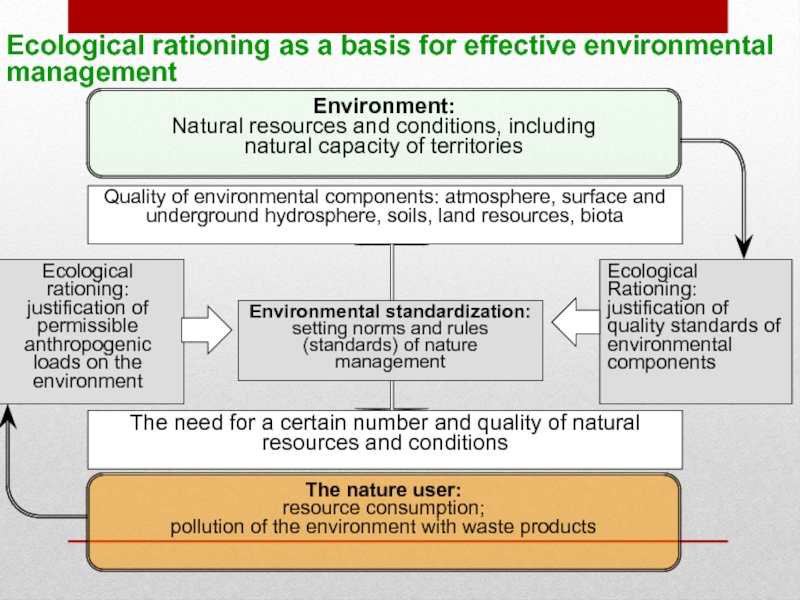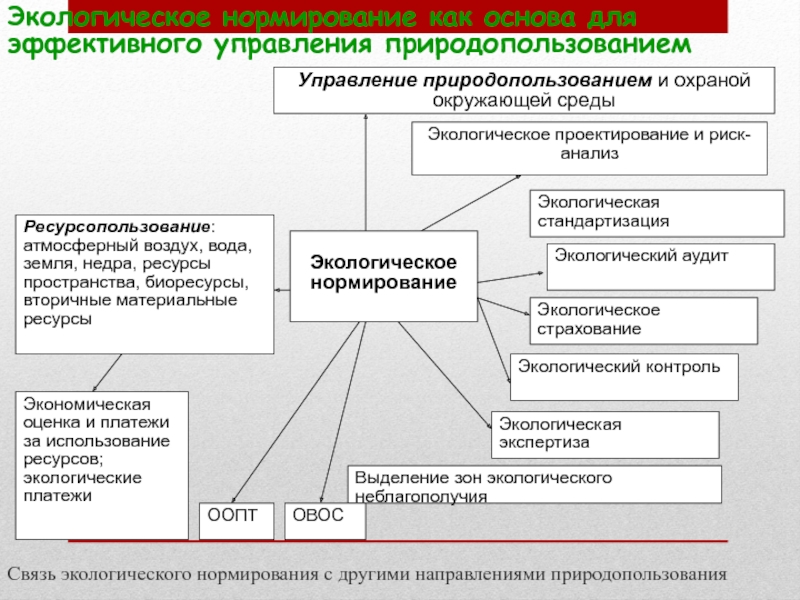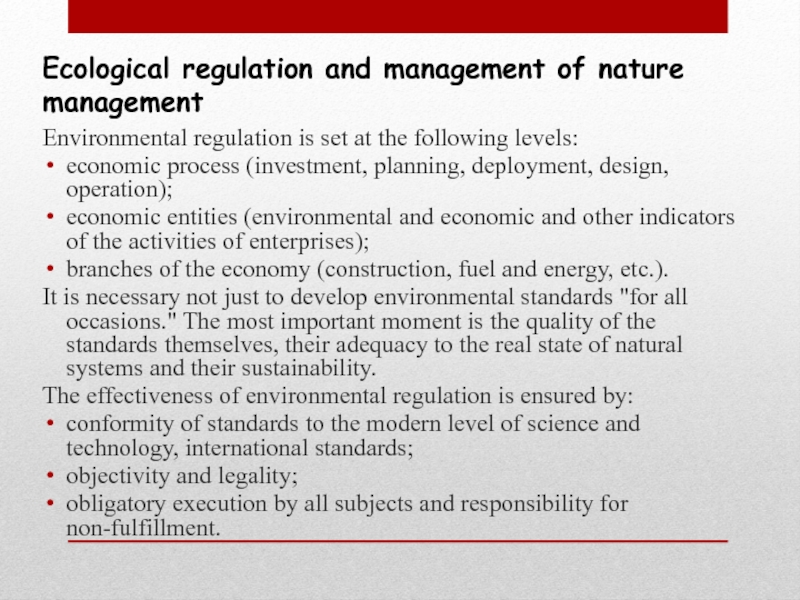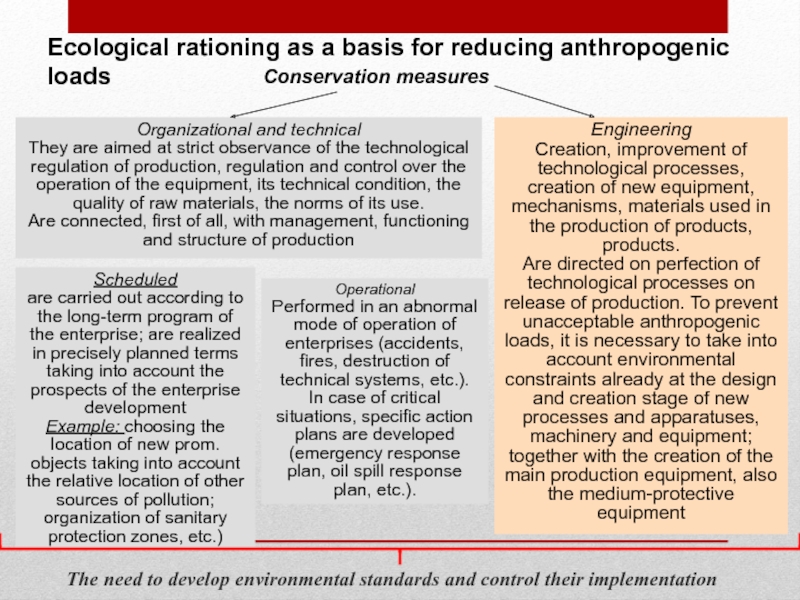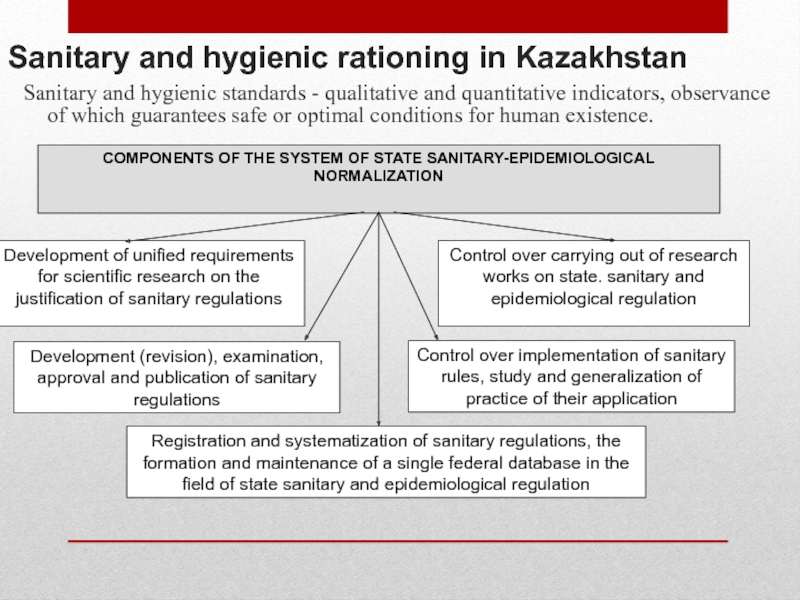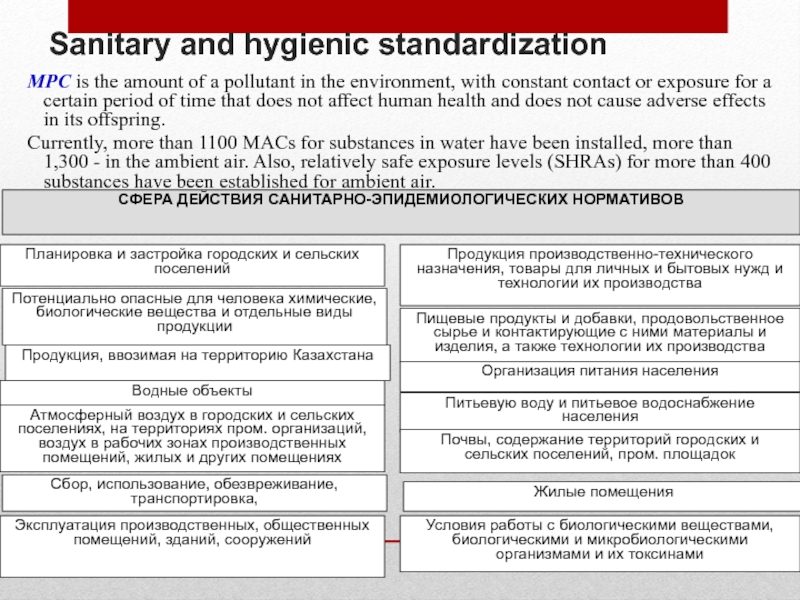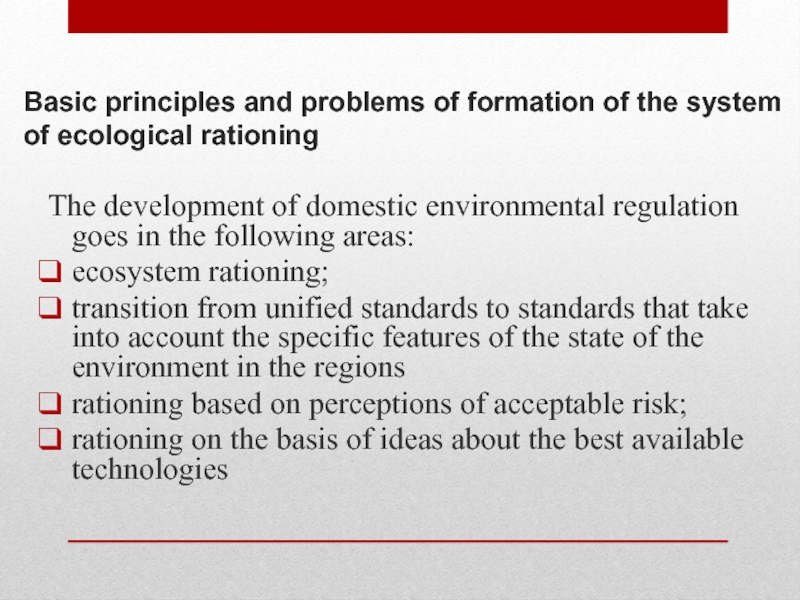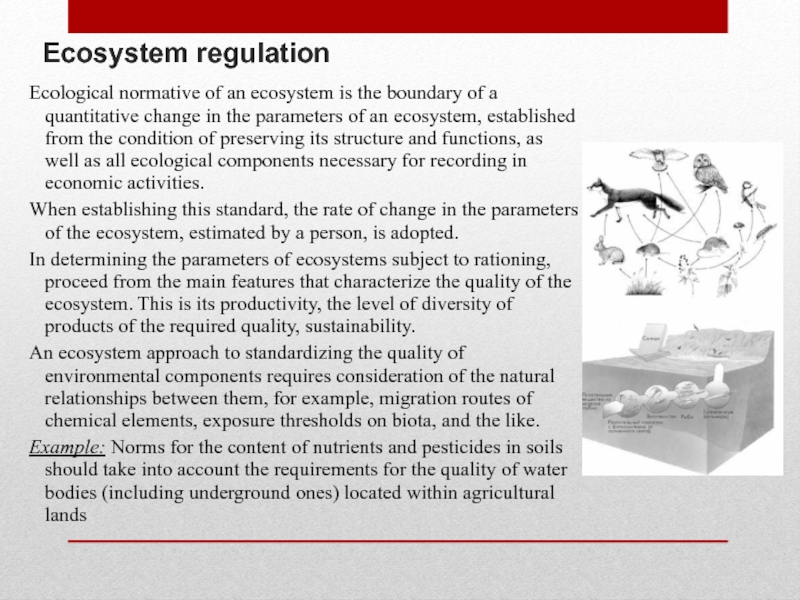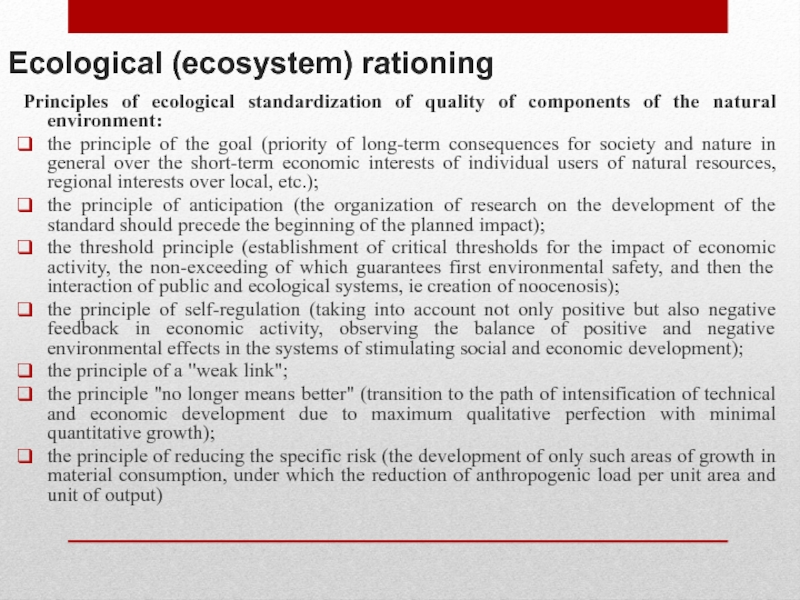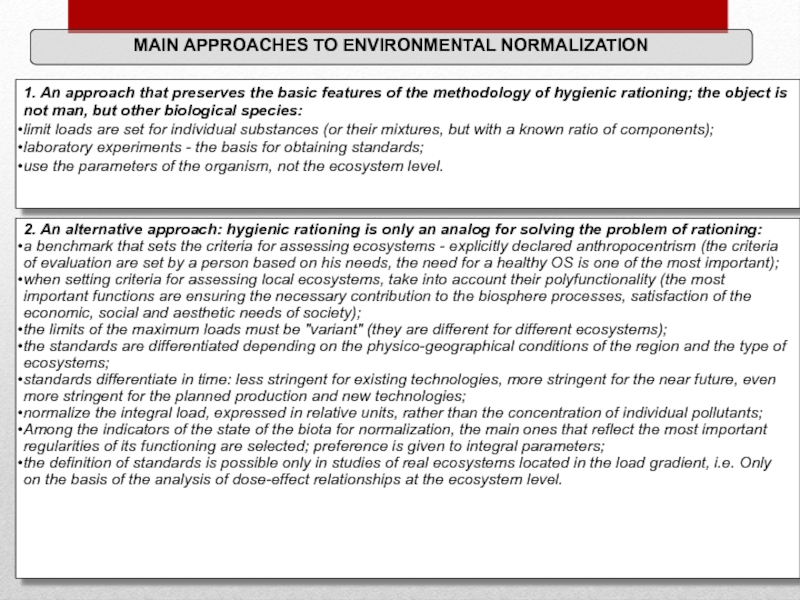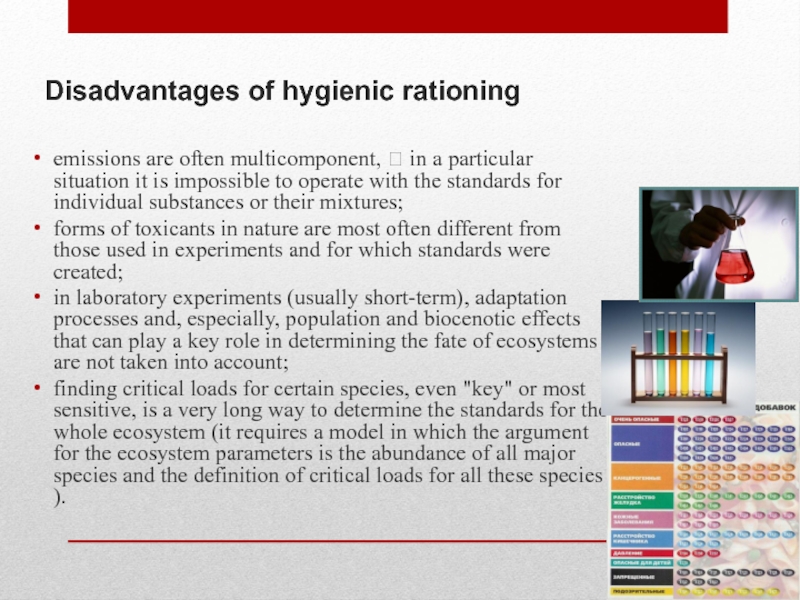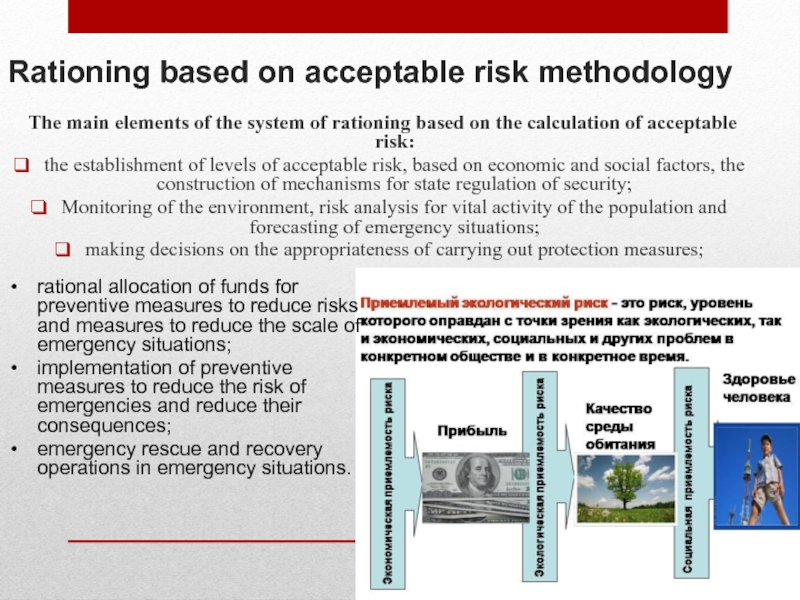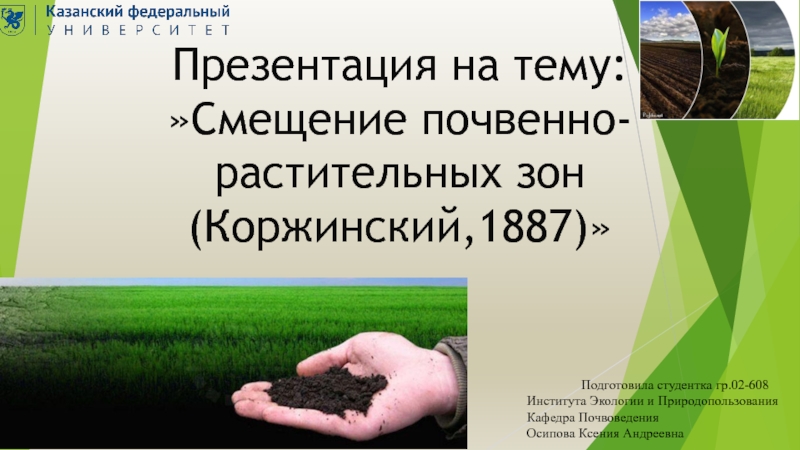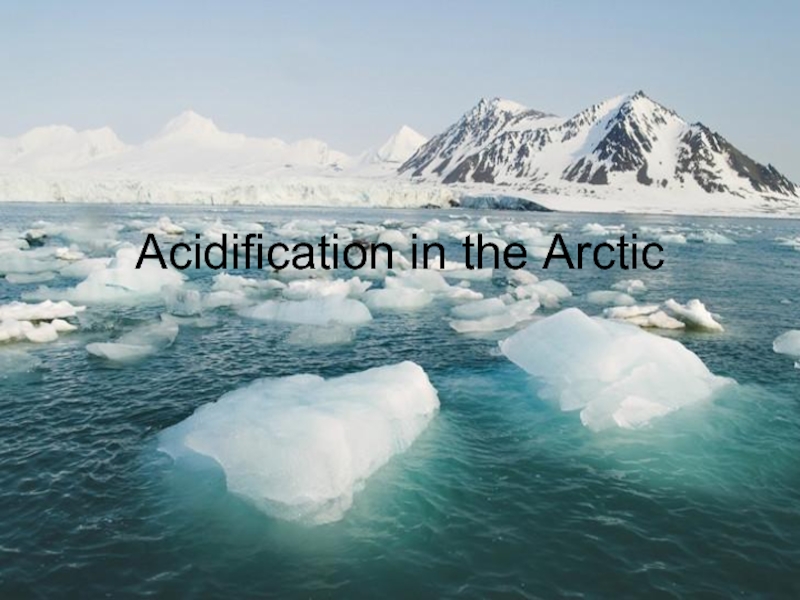- Главная
- Разное
- Дизайн
- Бизнес и предпринимательство
- Аналитика
- Образование
- Развлечения
- Красота и здоровье
- Финансы
- Государство
- Путешествия
- Спорт
- Недвижимость
- Армия
- Графика
- Культурология
- Еда и кулинария
- Лингвистика
- Английский язык
- Астрономия
- Алгебра
- Биология
- География
- Детские презентации
- Информатика
- История
- Литература
- Маркетинг
- Математика
- Медицина
- Менеджмент
- Музыка
- МХК
- Немецкий язык
- ОБЖ
- Обществознание
- Окружающий мир
- Педагогика
- Русский язык
- Технология
- Физика
- Философия
- Химия
- Шаблоны, картинки для презентаций
- Экология
- Экономика
- Юриспруденция
Ecological regulation and reduction of environmental pollution презентация
Содержание
- 1. Ecological regulation and reduction of environmental pollution
- 2. Basic concepts Environmental standardization is a special
- 3. Basic concepts The main task of environmental
- 4. The object and subject of environmental regulation
- 5. Stages of implementation of environmental regulation
- 6. Ecological rationing as a basis for effective environmental management
- 7. Экологическое нормирование как основа для эффективного управления
- 8. Ecological regulation and management of nature management
- 9. Ecological rationing as a basis for reducing
- 10. Sanitary and hygienic rationing in Kazakhstan Sanitary
- 11. Sanitary and hygienic standardization MPC is the
- 12. Basic principles and problems of formation of
- 13. Ecosystem regulation Ecological normative of an ecosystem
- 14. Ecological (ecosystem) rationing Principles of ecological standardization
- 15. MAIN APPROACHES TO ENVIRONMENTAL NORMALIZATION
- 16. Disadvantages of hygienic rationing emissions are often
- 17. Rationing based on acceptable risk methodology The
Слайд 1Ecological regulation and reduction of environmental pollution
Prepared: Dzhamalova G.
Group: Cht-14-4ra
Accepted: Kaldibaev
Слайд 2Basic concepts
Environmental standardization is a special research and regulatory and legal
Regulation in the field of environmental protection - scientific, legal, administrative and other activities aimed at establishing various standards - maximum permissible environmental impact standards, environmental quality standards, as well as state standards and other documents in the field of environmental protection, subject to compliance which do not degrade ecosystems, conservation of biological diversity and environmental safety of the population is guaranteed.
The purpose of environmental regulation is the management of nature use on the basis of knowledge of the laws of the functioning of natural systems and the organization of activities without disturbing them
Слайд 3Basic concepts
The main task of environmental regulation is the development and
The modern system of environmental regulation includes:
standardization,
licensing of certain activities in the field of environmental protection, as well as
environmental certification (mandatory or voluntary) in order to ensure environmentally safe implementation of economic and other activities
Слайд 4The object and subject of environmental regulation
The object of ecological rationing
For example: objects of ecological rationing:
Слайд 7Экологическое нормирование как основа для эффективного управления природопользованием
Связь экологического нормирования
Слайд 8Ecological regulation and management of nature management
Environmental regulation is set at
economic process (investment, planning, deployment, design, operation);
economic entities (environmental and economic and other indicators of the activities of enterprises);
branches of the economy (construction, fuel and energy, etc.).
It is necessary not just to develop environmental standards "for all occasions." The most important moment is the quality of the standards themselves, their adequacy to the real state of natural systems and their sustainability.
The effectiveness of environmental regulation is ensured by:
conformity of standards to the modern level of science and technology, international standards;
objectivity and legality;
obligatory execution by all subjects and responsibility for non-fulfillment.
Слайд 9Ecological rationing as a basis for reducing anthropogenic loads
The need to
Conservation measures
Organizational and technical
They are aimed at strict observance of the technological regulation of production, regulation and control over the operation of the equipment, its technical condition, the quality of raw materials, the norms of its use.
Are connected, first of all, with management, functioning and structure of production
Engineering
Creation, improvement of technological processes, creation of new equipment, mechanisms, materials used in the production of products, products.
Are directed on perfection of technological processes on release of production. To prevent unacceptable anthropogenic loads, it is necessary to take into account environmental constraints already at the design and creation stage of new processes and apparatuses, machinery and equipment; together with the creation of the main production equipment, also the medium-protective equipment
Scheduled
are carried out according to the long-term program of the enterprise; are realized in precisely planned terms taking into account the prospects of the enterprise development
Example: choosing the location of new prom. objects taking into account the relative location of other sources of pollution; organization of sanitary protection zones, etc.)
Operational
Performed in an abnormal mode of operation of enterprises (accidents, fires, destruction of technical systems, etc.).
In case of critical situations, specific action plans are developed (emergency response plan, oil spill response plan, etc.).
Слайд 10Sanitary and hygienic rationing in Kazakhstan
Sanitary and hygienic standards - qualitative
Слайд 11Sanitary and hygienic standardization
MPC is the amount of a pollutant in
Currently, more than 1100 MACs for substances in water have been installed, more than 1,300 - in the ambient air. Also, relatively safe exposure levels (SHRAs) for more than 400 substances have been established for ambient air.
Слайд 12Basic principles and problems of formation of the system of ecological
The development of domestic environmental regulation goes in the following areas:
ecosystem rationing;
transition from unified standards to standards that take into account the specific features of the state of the environment in the regions
rationing based on perceptions of acceptable risk;
rationing on the basis of ideas about the best available technologies
Слайд 13Ecosystem regulation
Ecological normative of an ecosystem is the boundary of a
When establishing this standard, the rate of change in the parameters of the ecosystem, estimated by a person, is adopted.
In determining the parameters of ecosystems subject to rationing, proceed from the main features that characterize the quality of the ecosystem. This is its productivity, the level of diversity of products of the required quality, sustainability.
An ecosystem approach to standardizing the quality of environmental components requires consideration of the natural relationships between them, for example, migration routes of chemical elements, exposure thresholds on biota, and the like.
Example: Norms for the content of nutrients and pesticides in soils should take into account the requirements for the quality of water bodies (including underground ones) located within agricultural lands
Слайд 14Ecological (ecosystem) rationing
Principles of ecological standardization of quality of components of
the principle of the goal (priority of long-term consequences for society and nature in general over the short-term economic interests of individual users of natural resources, regional interests over local, etc.);
the principle of anticipation (the organization of research on the development of the standard should precede the beginning of the planned impact);
the threshold principle (establishment of critical thresholds for the impact of economic activity, the non-exceeding of which guarantees first environmental safety, and then the interaction of public and ecological systems, ie creation of noocenosis);
the principle of self-regulation (taking into account not only positive but also negative feedback in economic activity, observing the balance of positive and negative environmental effects in the systems of stimulating social and economic development);
the principle of a "weak link";
the principle "no longer means better" (transition to the path of intensification of technical and economic development due to maximum qualitative perfection with minimal quantitative growth);
the principle of reducing the specific risk (the development of only such areas of growth in material consumption, under which the reduction of anthropogenic load per unit area and unit of output)
Слайд 15
MAIN APPROACHES TO ENVIRONMENTAL NORMALIZATION
1. An approach that preserves the basic
limit loads are set for individual substances (or their mixtures, but with a known ratio of components);
laboratory experiments - the basis for obtaining standards;
use the parameters of the organism, not the ecosystem level.
2. An alternative approach: hygienic rationing is only an analog for solving the problem of rationing:
a benchmark that sets the criteria for assessing ecosystems - explicitly declared anthropocentrism (the criteria of evaluation are set by a person based on his needs, the need for a healthy OS is one of the most important);
when setting criteria for assessing local ecosystems, take into account their polyfunctionality (the most important functions are ensuring the necessary contribution to the biosphere processes, satisfaction of the economic, social and aesthetic needs of society);
the limits of the maximum loads must be "variant" (they are different for different ecosystems);
the standards are differentiated depending on the physico-geographical conditions of the region and the type of ecosystems;
standards differentiate in time: less stringent for existing technologies, more stringent for the near future, even more stringent for the planned production and new technologies;
normalize the integral load, expressed in relative units, rather than the concentration of individual pollutants;
Among the indicators of the state of the biota for normalization, the main ones that reflect the most important regularities of its functioning are selected; preference is given to integral parameters;
the definition of standards is possible only in studies of real ecosystems located in the load gradient, i.e. Only on the basis of the analysis of dose-effect relationships at the ecosystem level.
Слайд 16Disadvantages of hygienic rationing
emissions are often multicomponent, in a particular
forms of toxicants in nature are most often different from those used in experiments and for which standards were created;
in laboratory experiments (usually short-term), adaptation processes and, especially, population and biocenotic effects that can play a key role in determining the fate of ecosystems are not taken into account;
finding critical loads for certain species, even "key" or most sensitive, is a very long way to determine the standards for the whole ecosystem (it requires a model in which the argument for the ecosystem parameters is the abundance of all major species and the definition of critical loads for all these species ).
Слайд 17Rationing based on acceptable risk methodology
The main elements of the system
the establishment of levels of acceptable risk, based on economic and social factors, the construction of mechanisms for state regulation of security;
Monitoring of the environment, risk analysis for vital activity of the population and forecasting of emergency situations;
making decisions on the appropriateness of carrying out protection measures;
rational allocation of funds for preventive measures to reduce risks and measures to reduce the scale of emergency situations;
implementation of preventive measures to reduce the risk of emergencies and reduce their consequences;
emergency rescue and recovery operations in emergency situations.
